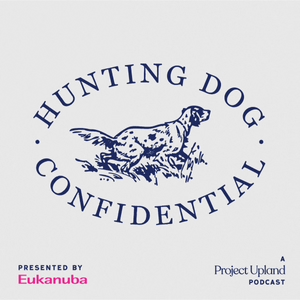
Episode 17: Teckels and Feist
12/10/20 • 55 min
1 Listener
In this episode, we explore two very different types of hunting dogs, both of which defy any attempt to fit neatly within a single category. Dachshunds, also known as Teckels or Dackels, are incredibly versatile hunting dogs that excel at hunting birds or tracking wounded game. Feist, on the other hand, are a category of dogs that represent the varied needs and preferences of squirrel hunters throughout North America. Both dogs are relatively unknown as hunting dogs outside of their circles, but within their community lies a fiercely devoted and passionate group of enthusiasts.
The Dachshund, or Teckel, originated in Germany and soon became a popular companion and hunting dog. War caused international interest in this German symbol to wane, leading to a short-lived attempt at renaming the breed “Liberty Hound.” The resilient little dog soon rebounded, though, and was once again popular around the world with hunters looking for a capable, driven dog with an expertise in tracking game as well as both bird dog and terrier-like skills.
Feist are a uniquely North American creation, bred to accompany squirrel hunters throughout Appalachia. They locate small game and tree it, keeping the animal in position until the hunter arrives to take the shot. While only two breeds of Feist are currently recognized by external registries, the category as a whole encompasses a huge array of local varieties and specialties.
As always, we explore some etymology in this episode. We explore the origin of the name “Teckel” and why the German word “Dachshund” isn’t often used within German to refer to this breed. We look into the meaning of “Feist” and how these dogs carry the name of an antique slang term. Finally, we start to build a dictionary of jaegersprache, or hunter’s language. The first entry in this list is “backing,” a term important in pointing dog culture but likely not understood outside of that world.
Tune in to learn more about Teckels and Feist! You’re nearly guaranteed to learn something new in this episode. We thank you for listening and hope you’ll continue to reach out with your comments, questions, and ideas. We can be reached at [email protected].
Share | Comment, review and discuss this episode of the podcast in our Project Upland Community Facebook group.
Enjoy the show and don’t forget to rate, review, subscribe, and share this podcast.
Hunting Dog Confidential is presented by Eukanuba Premium Performance Dog Food and supported by Dakota 283.
In this episode, we explore two very different types of hunting dogs, both of which defy any attempt to fit neatly within a single category. Dachshunds, also known as Teckels or Dackels, are incredibly versatile hunting dogs that excel at hunting birds or tracking wounded game. Feist, on the other hand, are a category of dogs that represent the varied needs and preferences of squirrel hunters throughout North America. Both dogs are relatively unknown as hunting dogs outside of their circles, but within their community lies a fiercely devoted and passionate group of enthusiasts.
The Dachshund, or Teckel, originated in Germany and soon became a popular companion and hunting dog. War caused international interest in this German symbol to wane, leading to a short-lived attempt at renaming the breed “Liberty Hound.” The resilient little dog soon rebounded, though, and was once again popular around the world with hunters looking for a capable, driven dog with an expertise in tracking game as well as both bird dog and terrier-like skills.
Feist are a uniquely North American creation, bred to accompany squirrel hunters throughout Appalachia. They locate small game and tree it, keeping the animal in position until the hunter arrives to take the shot. While only two breeds of Feist are currently recognized by external registries, the category as a whole encompasses a huge array of local varieties and specialties.
As always, we explore some etymology in this episode. We explore the origin of the name “Teckel” and why the German word “Dachshund” isn’t often used within German to refer to this breed. We look into the meaning of “Feist” and how these dogs carry the name of an antique slang term. Finally, we start to build a dictionary of jaegersprache, or hunter’s language. The first entry in this list is “backing,” a term important in pointing dog culture but likely not understood outside of that world.
Tune in to learn more about Teckels and Feist! You’re nearly guaranteed to learn something new in this episode. We thank you for listening and hope you’ll continue to reach out with your comments, questions, and ideas. We can be reached at [email protected].
Share | Comment, review and discuss this episode of the podcast in our Project Upland Community Facebook group.
Enjoy the show and don’t forget to rate, review, subscribe, and share this podcast.
Hunting Dog Confidential is presented by Eukanuba Premium Performance Dog Food and supported by Dakota 283.
Previous Episode

Episode 16: Scent Hounds, Running Hounds, and Badger Hounds
In this episode, we continue our journey through the hounds, moving into the well-known category of scent hounds. These dogs are characterized by their extraordinary ability to follow a scent trail, not only the fresh trail of a wounded animal, but also the “sweat trail” of an animal that may have passed through days earlier.
Scent hounds have enjoyed a prominent place in pop culture, with references and well-known examples ranging from Disney cartoons to the iconic song, “Hound Dog.” We dig into the meaning of the epithet “hound” and why Elvis—and many others—found reason to sing about it.
Scent hounds may be the great equalizer among the history of hunting dogs, because they were (and continue to be) used and loved by people across all economic and social classes. Working hounds run the gamut from fox hunts across wealthy estates in the English countryside to houndsmen and women running coonhounds in the southern United States. Whether the purpose is simply the thrill of the chase or to put meat on a table or pelts in the bag, the shared love for the dogs of the pursuit is universal.
For a little word trivia, we look into the etymology of “cur” and what makes curs especially versatile dogs for working and hunting. We also discuss the Dachshund and what makes this little Swiss Army knife dog so incredibly difficult to categorize.
Tune in to learn more about scent hounds and running hounds. As always, we thank you for listening and hope you’ll continue to reach out with your comments, questions, and ideas. We can be reached at [email protected].
Share | Comment, review and discuss this episode of the podcast in our Project Upland Community Facebook group.
Enjoy the show and don’t forget to rate, review, subscribe, and share this podcast.
Hunting Dog Confidential is presented by Eukanuba Premium Performance Dog Food and supported by Dakota 283.
Next Episode

Episode 18: Terriers
We wrap up our survey of hunting dogs with a look at working terriers. Terriers developed to fill a need where humans needed to get to game in a situation where we were ill-equipped to do so. Just like sight hounds were developed to be faster than us to catch running game, retrievers were developed to swim better than us to get game out of the water, and scenting dogs were developed with better noses than us to find otherwise-camouflaged game... terriers were developed to be able to locate and access game below ground in tunnels and dens.
Hunt terriers were valuable members of a hunting party because they could get the fox or rabbit out of a hole. The foxhounds and hunters relied on the terrier whenever the game “went to ground” so that the hunt could continue on with the chase and pursuit.
In order to pursue game underground, the terrier needs to have a small circumference, a huge amount of courage, and the tenacity to keep after the badger or fox to prevent it from digging deeper. This may involve nipping at the animal to keep its attention, or maneuvering around the animal in order to push it toward the burrow’s entrance. Either way, the terrier is adept at working in small, confined spaces with hostile game in its own den.
Terriers also proved their worth as effective vermin control, especially with rats and other rodents around the farm. This eventually gave way to the blood sport known as rat pitting, where terriers were placed in a pit with a number of rats and bets were placed on how quickly they could kill all of the rats. This was a popular entertainment event in pubs and, while not exactly hunting, is evidence of the terrier’s hunting origins and sheer tenacity.
We talk about a couple of popular working terrier breeds: the Jack Russell, the Fell Terrier, and the Jagdterrier, which was Germany’s versatile answer to the British terrier breeds. All of these dogs continue to enjoy strong working lines today.
In wrapping up the survey of hunting dogs, we wrap up season one of the Hunting Dog Confidential Podcast. In season two, we will host some guest interviews and invite listener questions and input. Would you like to have your question featured on an upcoming episode? Record a voice memo of your question, include your name and location, and email it to us at [email protected] . We look forward to hearing the voices of our listeners, answering your questions, and hearing your stories!
We thank you for listening and look forward to launching season two shortly.
Share | Comment, review and discuss this episode of the podcast in our Project Upland Community Facebook group.
Enjoy the show and don’t forget to rate, review, subscribe, and share this podcast.
Hunting Dog Confidential is presented by Eukanuba Premium Performance Dog Food and supported by Dakota 283.
If you like this episode you’ll love
Episode Comments
Generate a badge
Get a badge for your website that links back to this episode
<a href="https://goodpods.com/podcasts/hunting-dog-confidential-44266/episode-17-teckels-and-feist-10138051"> <img src="https://storage.googleapis.com/goodpods-images-bucket/badges/generic-badge-1.svg" alt="listen to episode 17: teckels and feist on goodpods" style="width: 225px" /> </a>
Copy




